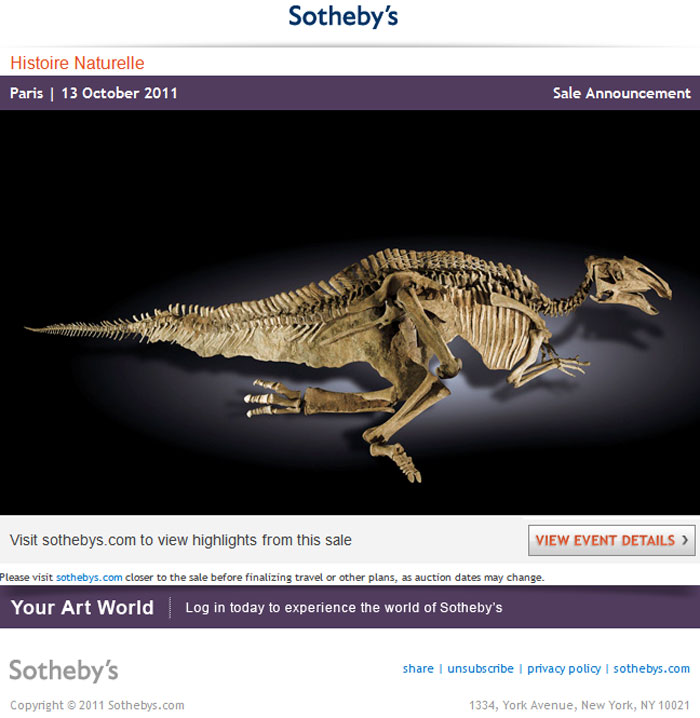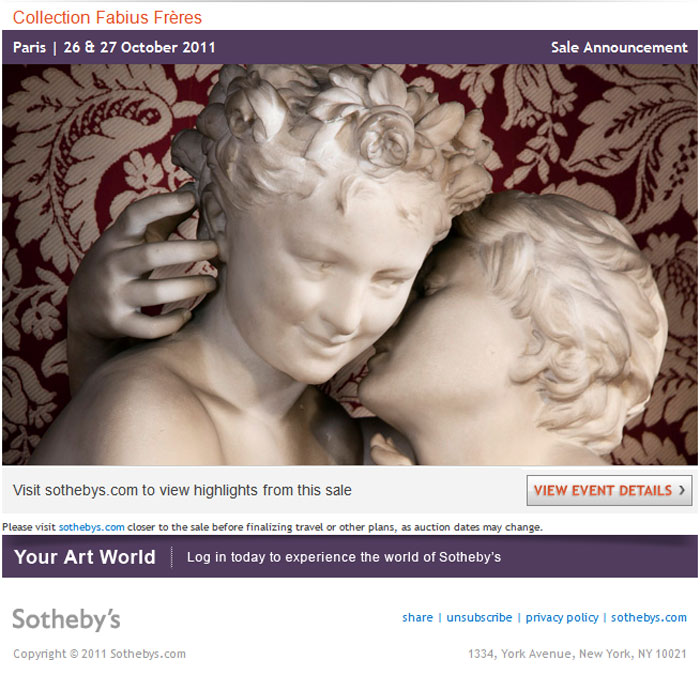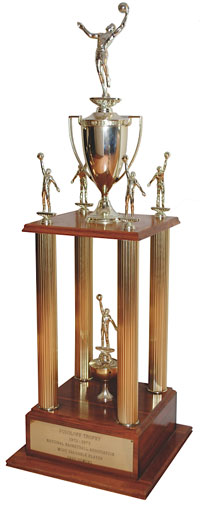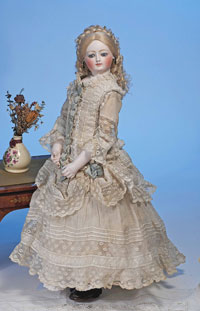Archive for July, 2011
Tonya A. Cameron Auctioneers’ sale featuring selections from the estate of Killer Kowalski
July 29th, 2011 by admin
An early publicity photo of champion wrestler Killer Kowalski, from a large selection of career ephemera to be auctioned. Tonya A. Cameron Auctioneers image.
SAUGUS, Mass. – A towering figure of a man, 6ft. 7in. Walter “Killer” Kowalski (1926-2008) was a world champion wrestler who enjoyed wealth and celebrity during his 30-year career in the ring. But there was much more to the man than just his ability to eliminate opponents with body slams, knee drops and his trademark “Kowalski claw,” said Tonya A. Cameron, who will auction selections from the Pro Wrestling Hall of Famer’s estate on Thursday, Aug. 11.
“I don’t know what I was expecting, but it was quite a surprise to discover that Mr. Kowalski was something of a modern day Renaissance man. He had many diverse interests, including photography and piloting his own plane to exotic locations,” Cameron said. “He was passionate about his charity work and his own successful businesses, was devoutly religious and was a committed vegetarian who frequently lectured on health and fitness.”
Kowalski and his wife Theresa, who survives him, enjoyed a comfortable lifestyle in their Boston-area home and “bought good things,” Cameron said. The couple’s china, glass, furniture, lighting and Asian antiques will be auctioned in Cameron’s 350-lot sale, together with their jewelry and a fascinating assemblage of wrestling memorabilia and apparel associated with Killer Kowalski’s career.
The china section of the sale includes complete Limoges services with game-bird motifs. One of the sets contains 12 plates and a large platter, each adorned with the image of a pheasant. Another Limoges set, consisting of six plates and a platter, has a fish theme.
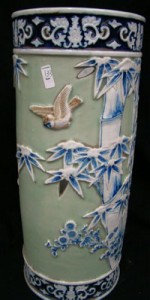
19th century Chinese celadon porcelain umbrella stand from the Kowalski residence. Tonya A. Cameron Auctioneers image.
An extensive Booth China “Blue Willow” dinner service for six includes numerous gilt-trimmed serving pieces such as tureens, a tray, gravy boat and teapot. A grouping of elegant Dresden dinner plates is accompanied by matching candlesticks.
An impressive collection of 19th-century Wedgwood includes 27 historical plates in cobalt blue and white. Also by Wedgwood, a large, deep-well meat platter with six matching plates displays a landscape-with-cows motif.
The Kowalskis’ glass collection includes Moser stemmed ware, Bristol glass, dresser bottles and numerous pieces of European and American brilliant-cut crystal. Additionally, there are console sets consisting of center bowls with matching candlesticks, perhaps by Cambridge.
An exceptional array of Bohemian glass includes a pair of heavy, 16-inch covered ruby glass mantel jars deeply etched with an elk and forest scene; and a pair of open ruby glass mantel vases with a motif of scrolling vines, landscaping and forest animals. Other prized Bohemian glass lots include large open baskets, heavy cobalt blue vases, and stemmed glassware.
The sale features several crystal chandeliers of various sizes – medium to large – including an Art Nouveau hanging ceiling fixture with four 1915 iridescent orange NuArt shades and lion-embellished drop-downs. Many excellent-quality lamps will be offered, as well as decorative brass and crystal wall sconces.
The Kowalskis also collected Asian art, some of which was purchased during trips to the Far East. Top pieces include an exquisite 19th-century Chinese celadon porcelain umbrella stand with bamboo decoration, 19th-century Asian vases, a spinach jade bowl, and cloisonné figural fish on pedestals. Handsome floor vases executed in shades of brown, blue, purple and orange display a chrysanthemum motif and have foo dog handles.
Leading the small selection of furniture are a custom-made bombe chest and an ornate 1920s French vitrine with swagged border. Classical scenes are painted on both of the vitrine’s side panels and on the bottom of the door.
Mr. Kowalski’s Rolex Oyster perpetual wristwatch will be auctioned, as will a sizable assortment of Theresa Kowalski’s Victorian jewelry, which has been grouped into one lot. The contents encompass a wide range of adornments: brooches, necklaces, lockets, miniature purses, and jade earrings with a matching ring. Other jewelry to be offered includes 14K gold pendants, charms, crosses and rings. A special highlight is the pair of 18K gold and enamel bee brooches with “jeweled” eyes.
Sports memorabilia collectors are expected to jump at the chance to own historical items and match-worn apparel direct from the estate of Killer Kowalski. Key pieces include Kowalski’s size 14 blue kid leather lace-up wrestling boots and three of his eye-catching robes. One of them is purple with silver metallic, while a second
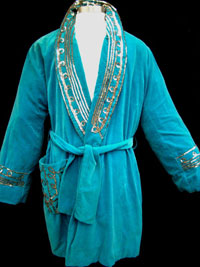
One of three flashy robes to be auctioned, each worn by Killer Kowalski in the ring prior to important matches. Tonya A. Cameron Auctioneers image.
robe is royal blue with gold metallic. The most important of the three robes dates to the 1950s, when Kowalski was wrestling under a different name: Wladek Kowalski. The robe is peacock blue velvet, with Kowalski’s name written in silver metallic script on the back.
The estate produced an immense amount of ephemera from Kowalski’s career. There are photos of him in his wrestling gear – some signed and some with other wrestlers – posters advertising wrestling matches, correspondence from the International Wrestling Federation, a letter confirming Kowalski’s election to the National Polish American Sports Hall of Fame, and even the Articles of Incorporation for his entertainment and recreation business, Victory Inc.
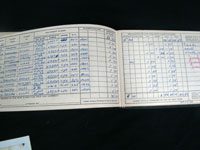
Walter “Killer” Kowalski was an accomplished pilot who logged thousands of hours in his private plane, as documented in this flight log. Tonya A. Cameron Auctioneers image.
Another lot with a close personal connection to Kowalski was his flight log. Tonya Cameron, herself a former Class C licensed pilot, said she was able to understand what the logbook’s entries meant and was “amazed to see how extensively he traveled…There was nowhere he wouldn’t go. He regarded his airplane the way most of us regard our cars.”
Tonya A. Cameron Auctioneers’ sale featuring selections from the estate of Killer Kowalski will take place on Aug. 11, 2011 at the company’s gallery at 113 Bennett Highway, Saugus, MA 01906, commencing at 5 p.m. Eastern time. All forms of bidding will be available, including telephone, absentee and online through Proxibid. For additional information, call 781-233-0006 or e-mail tac602@gmail.com. Visit Tonya A. Cameron Auctioneers online at www.tacauctioneers.com.
Rago Arts and Auction Center – 20th Century Decorative Arts & Furnishings
July 29th, 2011 by adminSotheby’s – Histoire Naturelle
July 29th, 2011 by adminSwann Galleries – Vintage Posters
July 29th, 2011 by adminSotheby’s – Collection Fabius Frères
July 29th, 2011 by adminSotheby’s is pleased to announce, in association with the auction house PIASA,
the sale of the Fabius Frères Gallery collection on the 26th and 27th October 2011 in Paris.
The 400 sculptures, pieces of furniture, works of art, drawings and 19th century paintings,
estimated to sell in the region of €10 million ($14,5 million), will be on view at the Galerie
Charpentier for five days prior to the sale. The Fabius Frères Gallery is known worldwide
for the exceptional quality, condition and provenance of the works of art in their collection.
Grey Flannel’s Aug. 12 Basketball HOF Induction Auction features five championship rings, Dave Cowens’ MVP Award, Dr. J’s ABA All-Star jersey
July 27th, 2011 by admin
1974 Julius “Dr. J” Erving ABA Eastern Conference All-Stars game-used uniform. Grey Flannel Auctions image.
WESTHAMPTON, N.Y. – Grey Flannel Auctions today announced details of its Sixth Annual Basketball Hall of Fame Induction Auction and other special events associated with the 2011 BHOF induction ceremony. The live auction will take place on Friday, Aug. 12 at the Naismith Memorial Basketball Hall of Fame in Springfield, Mass.
This year’s enshrinement is expected to attract a packed house of returning Hall of Famers and other VIPs. The Class of 2011 includes (alphabetically): Teresa Edwards, Artis Gilmore, Herb Magee, Chris Mullin, Dennis Rodman, Arvydas Sabonis, Satch Sanders, Tara VanDerveer and Tex Winter. Also, legendary Harlem Globetrotter and hook shot inventor Reece “Goose” Tatum will be inducted posthumously.
Grey Flannel Auctions will begin its Hall of Fame activities on Aug. 11 by hosting an invitation-only pre-induction dinner for Hall of Famers, inductees and industry dignitaries at the Hall of Fame’s Center Court. The following afternoon, starting at 1 p.m., Grey Flannel will conduct its 170-lot auction of vintage basketball-related memorabilia.
“The material in our Basketball Hall of Fame auction amazes me more and more each year, but this year’s selection tops all others,” said Grey Flannel Auctions’ president Richard E. Russek. “Many of the jerseys, uniforms and other mementos were consigned directly by players, their families or team employees, and at least 50 lots are accompanied by letters of authenticity from those sources.” Russek added that six Hall of Famers plan to attend the auction in person.
A featured highlight is the collection of veteran TV commentator and 25-time Emmy®Award winner Al Trautwig, whose

Two handwritten letters about Lew Alcindor that UCLA Bruins coach John Wooden sent in 1968 to Hall of Famer and close friend Charles “Stretch” Murphy. Grey Flannel Auctions image.
passion for a career in sports solidified during his teens, when he served as a ball boy for the ABA New York Nets and stick boy for the New York Islanders.
Among the most important items of game-used apparel in the Trautwig collection is Julius “Dr. J” Erving’s 1974 Eastern Conference ABA All-Star uniform. The striking red, white and blue uniform embellished with stars, Erving’s name, the number “32” and “ABA” is entered in the sale with a $10,000 reserve.
Another stellar lot is Rick Barry’s game-used ABA/NBA Super Games II uniform from 1972. “To our knowledge, this is the first ABA Super Games jersey ever to be offered at public auction,” said Russek.
While working for the Nets as a ball boy, Trautwig became a trusted insider, Russek said, sometimes even babysitting Rick Barry’s children. “The provenance for the Rick Barry Super Games jersey is direct and impeccable,” Russek said. “It comes with LOAs from both Rick Barry and Al Trautwig.” The jersey’s reserve is $5,000, although it is expected to go much higher. Russek explained:
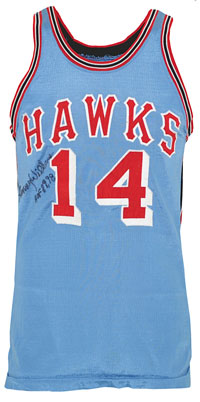
Circa 1967 Lenny Wilkens St. Louis Hawks game-used and autographed road jersey. Grey Flannel Auctions image.
“Rick Barry was named one of the 50 Greatest Players in History, and there’s tremendous interest, now, in game-used material connected to those Top 50 players. Collectors have become very competitive for these items and it has driven prices through the roof in our past sales. We expect to see a continuation of that trend in this sale,” Russek said.
A circa-1967 St. Louis Hawks game-used and autographed road jersey comes to auction from two-time Hall of Famer and Top 50 player Lenny Wilkens. “This is the only Lenny Wilkens game-used St. Louis Hawks jersey known to exist. There will be huge interest in this lot,” Russek predicted. “It has everything going for it – rarity, provenance, the connection to a Hall of Famer and Top 50 player, and an LOA from Lenny himself.” Reserve: $10,000.
Lot 30 in the auction consists of two letters the UCLA Bruins’ head coach John Wooden hand-wrote in 1968 to his close friend and fellow Hall of Famer Charles “Stretch” Murphy. The sensational contents of the letters detail in frank terms the strained relationship between Wooden and his star player Lew Alcindor (Kareem Abdul-Jabbar). “These eye-opening letters have to be read to be believed,” said Russek. They will be auctioned as one lot with a $10,000 reserve.
The auction inventory boasts five championship rings, including Robert Horry’s 2005 San Antonio Spurs World Championship ring and Bailey Howell’s 1968 Boston Celtics World Championship ring. On the collegiate side, there’s sure to be strong competition for Lynn Shackelford’s 1966-67 UCLA Bruins NCAA Championship ring.
Several items came directly to Grey Flannel from colorful Class of 2011 inductee Dennis Rodman. Within the selection are: the painting used as cover art for Rodman’s autobiography Bad As I Wanna Be, Rodman’s game-used Bulls sneakers, and an array of awards, including his 1990-91 NBA Defensive Player of the Year Award (reserve $2,500). Rodman’s much-publicized fling with Madonna is recalled in Lot 63 – a basketball hand painted with an alluring image of the athlete’s one-time girlfriend in scanty black lingerie.
The highest achievement to which an NBA player can aspire is the Most Valuable Player Award (a k a The Podoloff Trophy). For the first time ever, an NBA MVP Award will make its appearance at auction, when Grey Flannel opens the bidding on the 1972-73 trophy given to former Boston Celtic Dave Cowens. Standing 3ft. 9in. tall, the trophy comes straight from Cowens’ personal collection and is cataloged together with a photo match. This infinitely important award from a Hall of Famer and Top 50 player has been chosen to serve as the featured final lot of the sale and carries a reserve of $10,000.
Grey Flannel’s Friday, Aug. 12, 2011 auction will take place at the Naismith Memorial Basketball Hall of Fame, 1000 W. Columbus Ave., Springfield, MA 01105, starting at 1 p.m. Eastern Time. In addition to in-person and phone bidding, Grey Flannel welcomes absentee bids, including by phone (please call to reserve a line) and through its website: www.GreyFlannelAuctions.com. Printed catalogs are free to all registered bidders. The fully illustrated electronic version of the catalog may be viewed online at www.GreyFlannelAuctions.com.
To request a catalog, register as a bidder or obtain further information on any lot in the auction, call 631-288-7800, ext. 223; email gfcsports@aol.com.
Rare 1914 Albert Marque bisque doll a $168,000 thriller at Frasher’s July 9 auction
July 27th, 2011 by admin
Top lot of the sale, a French circa-1914 bisque doll created by sculptor Albert Marque, 22 inches, signed and incised with the number ‘12,’ $168,000. Image by Frasher’s Doll Auctions.
KANSAS CITY, Mo. – Sculpted by the renowned French artist Albert Marque (1872-1939), an extremely rare 1914 portrait doll originally commissioned for the Paris boutique Margaine-Lacroix sold to rousing applause for $168,000 (inclusive of 12% buyer’s premium) at Frasher’s July 9 auction. The buyer, who beat out four phone bidders and additional on-site bidders at the KCI-Expo Center in Kansas City, was new to Frasher’s client roster.
“The winning bidder is a collector of French dolls and German character dolls, and they obviously go for the very best,” said Barbara Frasher, president of Frasher’s Doll Auctions.
As noted by doll historians, during World War I, Albert Marque was persuaded by Parisian couturier Jeanne Margaine-LaCroix to sculpt 100 fashion dolls, each signed, numbered and clothed in a custom-designed costume representing royalty or a particular region of France. The exquisite 22-inch dolls were celebrated by the French not only as important artworks but also as cultural icons that stood up proudly to the influx of wartime dolls from Germany.
The “A. Marque” doll in Frasher’s sale was numbered “12,” making it a very early and desirable example. “I have only seen two other A. Marque dolls at auction with an earlier number,” said Frasher. “While it has been said that 100 of these dolls were commissioned, that number is speculative. The highest number I have ever seen on this type of doll was around ‘60.’”
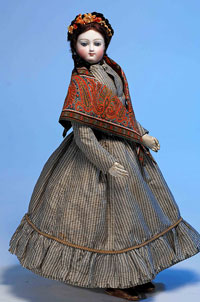
1872 French bisque poupee by Bru Jeune et Cie., 16 inches with ‘E’ mark, $3,737. Image by Frasher’s Doll Auctions.
Frasher said the quality of sculpting on the doll is “exquisite…You can tell that it was the work of an accomplished sculptor, not only from the quality of the doll’s head, but also the hands. The bisque head and limbs were added to a uniquely flared torso designed by French artist Aristodema Botta. The entire presentation is very unusual.” The doll was a popular attraction at the auction preview, Frasher said, because many collectors had never before had the opportunity to examine a rare A. Marque doll in person.
In 1993, Frasher’s made headlines with another French doll. The rare, 23½-inch exhibition model depicting an elegant Creole lady was produced by Jumeau expressly for the 1884 World Exposition in New Orleans. At Frasher’s, it sold for $231,000, and in so doing, set a world auction record for a French doll – a distinction that remained unchallenged for 17 years.
The A. Marque doll sold on July 9 came from one of three private collections featured in Frasher’s 277-lot sale. After the event, which grossed $418,670, dolls were shipped to points throughout the United States as well as to Russia, the United Kingdom, Australia, Italy, France, Germany and the Netherlands.
Barbara Frasher noted that approximately 20% to 25% of the sale was sold over the phones, with significant underbidding from the Internet. The top lot purchased online through LiveAuctioneers.com was a circa-1880 French bisque, wood-bodied fashion doll attributed to Louis Doleac, which realized $10,305.
Another highlight was the especially nice 24-inch bisque Bebe Triste by Emile Jumeau, with very finely painted facial features and blue paperweight eyes that rendered a melancholy expression. The doll settled at the midpoint of its estimate, selling for $15,680.
Another fine Jumeau, a circa-1878 Premiere Bebe, was noted as being the earliest of its particular type. Described in the auction catalog as having “superb complexion, modeling and expression, and exceptional eyes,” the 15-inch bisque beauty featured an excellent original body, wore a fine fitted silk couture costume and bore a “Jumeau Medaille d’or Paris” stamp. It sold within estimate for $7,280.
Other notable lots included a circa-1850s Mme. Leontine Rohmer petite poupee, 14 inches in length, with rare swivel-neck design and almond-shape cobalt glass eyes. Its all-original body included porcelain

Circa-1850s Mme. Leontine Rohmer poupee with rare swivel neck and cobalt glass eyes, 14 inches, $6,325. Image by Frasher’s Doll Auctions.
forearms. The coveted French fashion doll clothed in a deep-burgundy gown and straw bonnet exceeded its presale estimate to finish at $6,325.
Additional highlights included a classic 1872 Bru bisque poupee, 16 inches with “E” mark, $3,737; a petite Steiner bebe, 10½ inches with a label from the Parisian doll shop Au Nain Bleu, $3,920; and a highly sought-after model of the Emile Douillet Jumeau bebe with “E.D.” signature, $4,600. An 18-inch Francois Gauthier (F.G.) French bisque bebe with an “A La Tention, Guyot” shop label was bid to $5,040.
A section of the sale that “caught fire” with collectors was the extensive offering of doll costumes and clothing. “Some of the dresses brought as much as $1,500; and some of the bonnets went for $500 to $600 apiece. There’s a huge interest in accessories and clothing,” said Frasher. “Costuming a doll to make it one’s own is something collectors really enjoy. The highest prices are paid for antique clothing in good condition, but there’s also a strong market for contemporary productions replicating period clothing.”
Frasher, whose doll-auction business is now in its 29th year, said gloomy economic news has not deterred collectors from bidding on dolls. She believes that, overall, the doll market is stronger than some other avenues for investment.

Francois Gauthier (F.G.) French bisque bebe with ‘A La Tention, Guyot’ shop label, 18 inches, $5,040.
“Collectors have concluded that owning dolls brings them enjoyment and that they are a pretty sound investment over the long term. They’re not like a stock. You can hold them in your hand and enjoy them. The fact that there are still a lot of quality dolls coming onto the market and attracting good prices is a positive sign.”
Frasher’s Doll Auctions will hold its next event on Nov. 5-6, 2011, again at the KCI-Expo Center. The approximately 300-lot sale will have a heavy emphasis on French and other high-quality dolls. The inventory will also include a large selection of vintage costumes, dresses, bonnets and accessories. Quality consignments are currently being accepted for Frasher’s January auction in Scottsdale, Arizona – now a 20-year tradition with antique doll buyers.
To contact Frasher’s Doll Auctions, call 816-625-3786 or e-mail frasher@aol.com.
XXVII FLORENCE INTERNATIONAL ANTIQUES FAIR October 1-9, 2011 at the Palazzo Corsini
July 26th, 2011 by adminThe 27th Florence International Antiques Fair (aka Florence Biennale) will be hosted this year at the enchanting Palazzo Corsini from October 1st– 9th with a layout masterminded by the Maestro Pier Luigi Pizzi. The Biennale, first started by Mario and Giuseppe Bellini in 1959, is the oldest continuous art and antiques fair in Europe and has become the most important Italian art exhibition in the world.
The home to the bi-yearly Florence Biennale since 1997, the Palazzo Corsini in its subdued Baroque style with an 18th-century flair is truly a unique and greatly admired building in Florence and a sight to see in itself. The residence, which was completed only in 1737, is also the proud home of Florence’s most important and historically significant private gallery, boasting a collection, begun in 1765 by Don Lorenzo Corsini, nephew of Pope Clement XII.
The works of art displayed by antiquarians from all over the world–74 Italian and 14 foreign—are the undisputed stars of the show. The vast variety of the over 3,000 pieces presented at the fair range from paintings to plates and antique books to sculptures.
All the works exhibited at the Biennale will be monitored and authenticated by the Scientific Committee. On September 28th, two Committees, the first appointed by the Florence Exports Office, and the second sent by the Ministry for the Cultural Heritage, will examine the works for which the antiquarians request a free circulation certificate, a document which allows Italian works of art to circulate abroad.
Collateral Events:
The Biennale continues to support Corri la Vita, an association, devoted to the study and prevention of breast cancer presided over by the Marchioness Bona Frescobaldi. On October 1st a charity evening will be held and during the dinner Christie’s will auction works of art donated by exhibitors at the Biennale. The proceeds of the auction will be devolved entirely in favour of the Association.
On October 5th prizes will be awarded to the best painting and sculpture at the Fair. The prizes, amounting to 10,000 Euro each, will be destined to the restoration of a work of art from the public cultural heritage.
On October 6th the “Lorenzo d’oro” prize will be awarded to Piero Angela, for his long and successful career as a director of documentaries.
Press Office:
Sveva Fede, tel. +39 336 693 367, tel. e fax +39 0575 370 368, sveva.fede@libero.it
Press Office for Tuscany:
Anna Pampaloni, tel. +39 055 69 63 65, +39 347 56 20 327, a.pampa@katamail.com
Foreign Press Offices:
Great Britain: Cawdell Douglas, 10-11 Lower John Street, W1R 3PE London (GB), tel. +44 207 439 28 22, fax +44 207 287 54 88, e-mail: press@cawdelldouglas.co.uk
U.S.A.: Jonathan Marder + Company, 24 Fifth Avenue, suite 1530, N.Y. 10011 New York (U.S.A.), tel. +1 646 638 24 79 fax + 1 646 638 25 29, e-mail: m.dattatreya@gsmltd.net
France: Colonnes, Claire Galimard, 16 rue des Saints-Pères, 75007 Paris (France), tel. +33 1 426 070 10, fax +33 1 426 070 07, e-mail: contact@colonnes.com
Info:
Expo Arte e Cultura S.r.l. – Via del Parione 11 – 50123 Firenze – tel. +39 055 282 283 – +39 055 282 635 – Fax +39 055 214 831 – www.biennaleantiquariato.it – info@biennaleantiquariato.it
Short history of the Florence International Antiques Fair
• The Mostra Internazionale dell’Antiquariato was launched in 1959 in the prestigious premises of Palazzo Strozzi. The Fair was the brainchild of Luigi Bellini Sr., designed to attract to Florence the very best in the international antiques world, and it made its name by offering the choicest selection in the collecting and antiques sector. The overwhelming success of the first Fair, and of those which followed, marked the start of a market season increasingly oriented towards the Antiques Fairs. The originality of the idea, accompanied by an astute selection of the antiquarians, transformed the Fair into a cultural and fashionable event that could not be missed, to the extent that the Florentine Fair was visited both by the members of the international jet set and by a crowd avid for curiosities, knowledge and marvels. The international triumph was triggered by the fact that it was held in Florence and was also accompanied for the entire duration by a series of highly attractive cultural and society events.
- Problems in the utilisation of Palazzo Strozzi, where adaptation work was being carried out, meant that in 1977 the antiquarians had to move to Palazzo Giuntini (now the Grand Hotel), after which they returned to the original site up to 1993. In 1987, Guido Bartolozzi took over from the Bellini brothers as the General Secretary.
- When Palazzo Strozzi became definitively unavailable in 1995 the Fair had to be moved to the Palazzo degli Affari, a fine building designed by Spadolini, but entirely unsuitable for an antiquarian fair of the level of the Florentine Biennale. For the following editions of the Fair, the choice fell on Palazzo Corsini sull’Arno, the current premises of the event, where it has been held since 1997.
• In 2001 the Management Committee appointed Giovanni Pratesi, Chairman of the Italian Antiquarians Association, as General Secretary of the Florentine Biennale. This appointment represented a crucial turning-point for the Fair and it was in fact in 2001, with an absolutely innovative design and the inclusion of numerous novelties in the general programme, that the Biennale set off on the path that has led to its being considered today as one of the three most important antiques events in the world.
• To place the Biennale at the level of the most prestigious international Fairs it was decided to promote strict controls on the works displayed, modify the image of the Fair by entrusting the orchestration to the Maestro Pier Luigi Pizzi, who performed an authentic masterpiece of restyling, introducing a new pavilion in the entrance courtyard of the Palazzo, boost promotion by setting up specialised Press Offices in the major cities of the world (Wiesbaden, London, Paris, New York); extend to the Italian exhibitors the same rights as their foreign counterparts, offering them advance examination of the works on display so as to provide them with export licences before the start of the Fair.
THE CORSINI PALACE
Maria Maddalena Machiavelli, wife of Marchese Filippo Corsini, purchased the Palace from the Grand Duke Ferdinando II in 1649. Her son, Bartolomeo, began remodelling and redecorating the Palace in 1650. Initially the work was done by Alfonso Parigi the Younger, and then by Ferdinando Tacca, who continued with the project until 1671. Actual construction work on the Palace as it stands today was commissioned by Filippo Corsini junior, in 1685, after the death of his father Bartolomeo. Construction was directed by Antonio Ferri, a versatile exponent of the late Baroque Florentine culture. He was a set designer and engineer, who built machines and fortifications and than poured his extraordinary elegance and creative skill into Palazzo Corsini, making it one of Florence most unusually luxurious palaces.
The decorations, executed between 1692 and 1700, are among the finest examples of Florentine painting. Among the artists the Corsini family commissioned to decorate the located, we must mention the outstanding maters Anton Domenico Gabbiani, Alessandro Gherardini and Pier Dandini.
Palazzo Corsini, located on the banks of the Arno river, is in the heart of Florence, just a short walk from the Ponte Vecchio and the Duomo and near the smart Via Tornabuoni.
The Salon and the Aurora Gallery
When the Salon in the Palazzo Corsini was inaugurated in the late seventeenth century, Antonio Ferri’s designs (1694‑1696) must have aroused widespread amazement. Entering the room from the grand staircase, which forces a corner view, is an enormous source of wonder. The visitor sees an extraordinary room flooded with light reflected from the walls with their columns, bases and rippling cornice. The ceiling in the Salon is decorated with a glorification of the Corsini family, and it supports two gigantic painted wooden chandeliers that were carved by Antonio Francesco Gonelli between 1698 and 1700. The doors of the Salon open onto the adjacent decorated rooms.
Size and prestigious location make this splendid salon one of the most sought after reception rooms in the heart of Florence.
The impressive main staircase leads to the Aurora Gallery which is part of the main building: its large, arched windows look onto the courtyard and offer a splendid view of hills on the opposite side of the Arno river.
This luminous and completely frescoed gallery was decorated by Bartolomeo Neri and Alessandro Rosi, and with the other luxurious rooms of Palazzo Corsini, will house, from the 30th September to the 9th October, the 24th edition of the International Antique Fair.
The Ballroom
The Ballroom, that overlooks an internal courtyard, is reached via the middle door (on the left) of the Salon. The large crystal chandelier and the gilded eighteenth century wall sconces complete the decorations.
The fresco, painted by Alessandro Gherardini between 1695 and 1696 is set in a plasterwork frame enhanced with flowers and two scrolls. In the middle of the composition in Aurora’s chariot drawn by Pegasus. The goddess of dawn, sister of Helios, the sun god, is surrounded by three maidens, the Hours, one of whom is holding a floral crown, while a Putto holding a torch, symbol of the goddess, precedes the chariot. On one edge of the fresco, Gherardini painted the Kingdom of Flora, with Zephyr, the young god with butterfly wings and some nymphs accompanying the goddess. On the opposite side is the Triumph of Galatea: the sea nymph is on a shell drawn by dolphins, and Polyphemus with his heard is in front of her, playing a love song on his pipe. The care the artist dedicated to the fresco is the further enhanced by the decorative elements he added: four vases in the corners of the arch; those near the Kingdom of Flora are decorated with garlands of flowers, the other two with sea creature and fish. It can be easily said that this fresco is the finest decorative work in the entire Palace.
During the Antiques Fair, the padded and lined with precious silk seats will be removed to protect their integrity.




